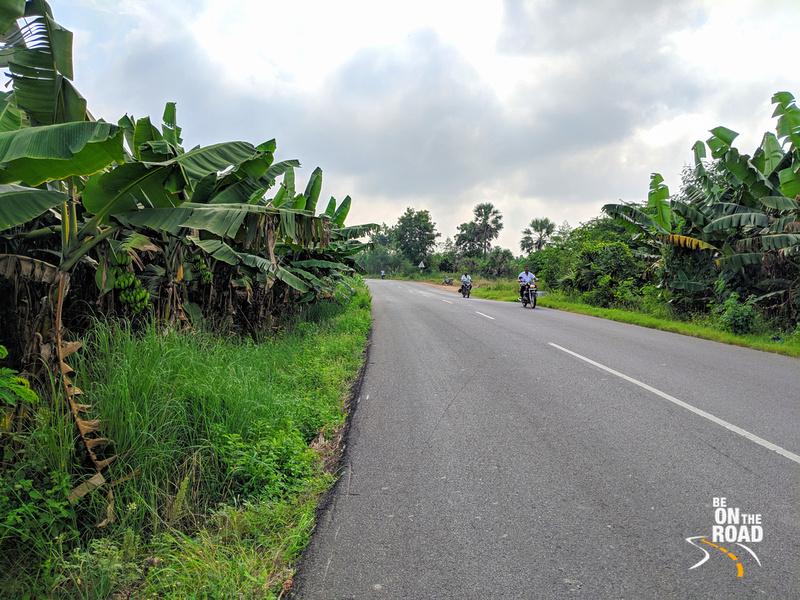Thamirabarani River Delta: A Motorcycle Route full of Rustic Gorgeousness

This perennial holy river is the lifeline of India’s deep south. Originating in the Agasthyamalai biosphere reserve, the Thamirabarani river criss-crosses through tropical forests comprising of medicinal plants and herbs, tumbling into many waterfalls, crossing many lush agriculture driven ancient villages before it joins the Bay of Bengal between Tiruchendur and Tuticorin. In its short journey of 128 kms from start to end, it leaves a significant impact on the people of South Tamil Nadu. Not only because it is the only perennial river of Tamil Nadu, but also because its presence has given birth to a rich ecosystem, a spectacular landscape, a vibrant culture and some fantastic people.
The story of Thamirabarani river is so rich that one can do a road trip tracing the journey of the river from top to end. But, if you don’t have that kind of time, you most certainly can explore the Thamirabarani river delta that is full of lush green landscapes, magical villages, gorgeous temples and some amazing traditions.
Thamirabarani river, which literally means copper colored leaf or river of red leaves, is recognized as a holy river in the Puranas, Mahabharata, Ramayana and ancient Sangam Tamil literature. Many famous temples can be found on its banks. Some of these temples were built during the reign of the earlier Pandyan kings, while some are from a much earlier time. It’s year round water supply and many irrigation channels ensures that most of its path remains lush and fertile throughout the year, thus giving birth to multiple cycles of paddy, banana and other agriculture. This abundant farmland along with pretty little villages is one of the main charms of following the Thamirabarani river and more so along the delta where this green view spreads as far as the eyes can see.
Umpteen bridges, miles and miles of paddy, fresh banana plantations, palm trees and the Thamirabarani river and its tributaries and distributaries greet you along the route. Sivalaperi village, where the last tributary ‘Chittar’ joins the Thamirabharani to Punnaikayal and Pazhayakayal where Thamirabarani joins the Bay of Bengal at the Gulf of Mannar is the stretch of the rich Thamirabarani delta. Sri Kailasanatahr temple at Murappunadu, Amman Kovil at Ponnankurichi, Srivaikuntam, Alwarthirunagari, Agni Teertham beach and the Tiruchendur Murugan temple are some of the key highlights on this eye catching route.

The villages of Thamirabarani are its main charm. And this route has such villages by the dozen. Each one more charming and captivating than the other. If you are looking for a seriously offbeat motorcycling route, the Thamirabarani river delta highway has to one of the top choices, especially if you happen to go on a ride during the North East monsoon or right after it. From the Western Ghats to the Bay of Bengal or from Sivalaperi village to Agni Teertham beach, the Thamirabarani way of life is bound to bowl you over. I can’t stop raving about it. May be, because, I have Thamirabarani in my DNA too!

How to reach there:
The nearest airport would be Tuticorin. The nearest large railway station would be Tirunelveli. The nearest large bus station would also be Tirunelveli.
The Tirunelveli to Tiruchendur route is the one that gives you the best view of the Thamirabarani delta. You can also find lush countryside view between Papanasam and Tirunelveli.

Where to stay:
If you prefer luxurious accommodation, try out the hotels in Tirunelveli.
If you prefer village stays, try out homestays or Airbnb in the Thamirabarani countryside.
If you prefer forest stays, try the forest accommodation inside Kalakad Mundanthurai tiger reserve.
Where to eat:
You will find traditional meals at many villages along the Thamirabarani river. My personal favorites are Hotel Ramanas at Ambasamudram and the traditional chukku kaapi near its waterfalls or at Papanasam. The villages along the Thamirabarani are also famous for nongu and padhani, the refreshing and very delicious fruit and drink.
If you wish to eat at nicer places, I would recommend the city of Tirunelveli. Hotel Nellai Saravana Bhavan, Janakiram, Ramprasad and Annapoorna are the top choices for delicious vegetarian food. Do not miss to taste the iconic dessert of Tirunelveli at Iruttu Kadai Halwa.

Places worth seeing close to the Thamarabharani river:
1) Kalakad Mundanthurai Tiger Reserve: Thamirabarani river and its tributaries flow through this pristine ecosystem
2) 7th century Nellaiappar Temple: A massive temple that is located by the banks of the Thamirabarani river
3) 1000 year old Papanasanathar Temple: A temple located right next to the Thamirabarani river only a few kilometers from its starting point
4) Kallidaikurichi: The village of the saaral season that is located on the banks of the Thamirabarani river
5) Karaiyar Dam: Offbeat wildlife and nature holiday destination
6) Tiruchendur Murugan Temple: Sea-shore magic located very close to where the Tamirabarani river meets the sea
7) Manjolai: The hill station of South Tamil Nadu famous for its tea estates, panoramic vistas and rich wildlife
8) Agastiyar Falls: One of the many gorgeous waterfalls on this river






























































